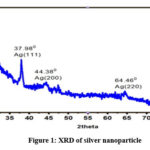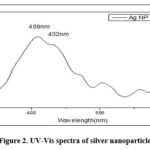Sorna Gowri Vijaya Kumar*
Principal Technical Officer, CSIR-AMPRI and Associate Professor, AcSIR, AMPRI, Hoshangabad Road, Habibaganj Naka, Bhopal, M.P, India
Corresponding Author E-mail: gowrisorna@yahoo.com
DOI : http://dx.doi.org/10.13005/msri/200208
Article Publishing History
Article Received on : 27 Jul 2023
Article Accepted on : 14 Aug 2023
Article Published : 23 Aug 2023
Plagiarism Check: Yes
Reviewed by: Dr. Angulakshmi Prabu
Second Review by: Dr. Saravanan Krishnan Final Approval by: Dr. Ozan Toprakci
Final Approval by: Dr. Ozan Toprakci
Article Metrics
ABSTRACT:
The antimicrobial cotton fabric has been prepared by coating it with Ag treated with SDS(Sodium dodecyl sulphate) nanocoating and its antimicrobial properties have been tested. It is observed in the present study, that the nanocoating coated cotton fabrics have good antimicrobial properties. The coated cotton fabric showed an antibacterial activity value of 5.86 against Klebsiella pneumonia ATCC 4352 and that of 4.89 against Staphylococcus aureus ATCC 6538 when tested according to the JIS L 1902-2015 method.
KEYWORDS:
Antimicrobial; Cotton fabric; Ag nanocoating; Sodium Dodecyl Sulphate(SDS)
Copy the following to cite this article:
Kumar S. G. V. Antimicrobial Activity of SDS/Ag Treated Cotton Fabric. Mat. Sci. Res. India;20(2).
|
Copy the following to cite this URL:
Kumar S. G. V. Antimicrobial Activity of SDS/Ag Treated Cotton Fabric. Mat. Sci. Res. India;20(2). Available from: https://bit.ly/3ONFAZn
|
The fabrics are made antibacterial by incorporating antimicrobial agents into them1-3. A cheap and practical alternative can be to prolong the efficacy of the fabric like PPEs by providing intrinsically antimicrobial properties directly onto the fiber materials. Recently, metal nanoparticles (NPs) as antimicrobial agents have increasingly been used in textile research due to their unique large surface-to-volume ratio, physico- chemical properties and biological multi-target mechanism of action, which may differ considerably from bulk material4,5. Zinc oxide nanoparticles (ZnO) that are considered nontoxic and biocompatible in low concentrations and have been applied in different therapeutic applications as drug carriers and antimicrobial agent6,7. SDS is a sulfated surfactant that denatures membrane proteins of cells and pathogens. It thus has a dual action as a stabilizer and as an antimicrobial agent8. Previous studies have demonstrated that in vitro SDS inhibited the infectivity of HSV-1 to Vero cells at quite low concentrations, suggesting that SDS could be a potential candidate for use as a topical microbicide9. The development of these antimicrobial textiles that incorporate immobilized nanoparticles in SDS is a step beyond the current state-of-the-art. The interdisciplinary research field combining nanotechnology, biotechnology, and textile is still in its early stages. To our knowledge, the strategy proposed in the present work is unique and almost nothing is known about the properties and performance of such a system of silver nanoparticles and SDS which are complementary to each other in providing antimicrobial properties. In the present work, Ag treated with SDS nanocoatings were prepared and applied on cotton fabrics and their antimicrobial properties were studied.
Silver nitrate (AgNO3) was used as a precursor while Tri Sodium citrate (C6H5O7Na3) and Ascorbic acid (C6H8O6) were utilized as the reducing agent and surfactant, separately. To synthesize silver nanoparticles, initially, 80 ml of AgNO3 was heated to 60°C and then 20 ml of C6H5O7Na3 and C6H8O6 solutions, preheated to 60°C were added under stirring. The stirring of the above solution was continued for 20 minutes. After that, the solution was cooled to room temperature with continued stirring10.
Immediately after the synthesis to confirm the formation of Ag nanoparticles XRD characterization of the synthesized product has been carried out. The UV absorbance spectrum of the colloidal sample was also obtained in the range of 200–800 nm, using a UV–Vis spectrometer Shimadzu-UV 1800.
Fig. 1 shows the XRD analysis of powder silver nanoparticles. The presence of peaks at different 2θ values such as 37.98°, 44.38°, 64.46°and 77.02° correspond to (111), (200), (220), (311) planes of silver, respectively11. The peaks in the XRD pattern can be readily indexed to a face-centered cubic structure of the synthesized silver as per the literature (JCPDS, File No. 4-0783)12. The lattice constant calculated from the XRD pattern was found to be a = 0.4132 nm, which is almost close to the standard value, a = 0.4086 nm. The crystallite size (L) of the silver nanoparticles thin film has been evaluated by Scherrer’s formula in which λ is the wavelength (0.15418 Å) of X-rays, β is the broadening of diffraction line measured at half of its maximum intensity in radian unit, and θ is the diffraction angle in degrees. The crystallite size of the newly synthesized silver nanoparticles has been found to be 14.17 nm.
D=Kλ/βCosθ
Fig.2 shows UV-Vis spectra of silver nanoparticles showed an absorption peak of silver nanoparticles at about 409 nm, which confirms the formation of silver nanoparticles.
In the procedure for preparing the coated textile sample, 0.1 g of AgNP was added to 50 mL of the surfactant solutions with a concentration of 1 wt%. The dispersion was then ultrasonicated for 4 h and stirred for half an hour to get a homogenous solution. The cotton fabric was detergent washed; dried in the air before use. The cotton textile (3x3cm) was dipped in the above solution for one day. After that, the textile was air-dried. The add-on % of the coated fabric was about 20%. The coated cotton fabric was tested at BTRA, Mumbai. The coated cotton fabric was tested at BTRA, Mumbai. for antibacterial activity value against Klebsiella pneumoniae by ATCC 4352 and against Staphylococcus aureus by ATCC 6538 when tested as per JIS L 1902-2015 Method.
The sample was kept under observation in contact with individual test organisms for 18-24 hrs shows results as given in Table 1
Table 1. Antibacterial activity value of coated textile
|
Sample
|
Test organism
|
Growth Value on Control Specimen
|
Growth Value on Test Specimen
|
Antibacterial Activity Value (A Value)
|
|
Coated cotton fabric
|
Staphylococcus aureus ATCC 6538
|
2.05
|
-3.81
|
5.86
|
|
Klebsiella pneumonia ATCC 4352
|
1.20
|
-3.69
|
4.89
|
|
Sample
|
Staphylococcus aureus ATCC 6538
|
Klebsiella pneumonia ATCC 4352
|
|
Growth under specimen
|
Zone of inhibition
|
Growth under specimen
|
Growth under specimen
|
Zone of inhibition
|
Zone of inhibition in mm
|
|
Coated cotton fabric
|
Absent
|
Absent
|
–
|
Absent
|
Absent
|
–
|
The antimicrobial test shows, the growth value on the control specimen as 2.05 against Staphylococcus aureus by ATCC 4352 and 1.20 against Klebsiella pneumonia by ATCC 6538. The corresponding values for the coated textile samples are -3.81 and -3.69 as shown in Table 1. Ag nanocoating coated cotton fabric showed an Antibacterial Activity value of 5.86 against Klebsiella pneumonia ATCC 4352 and that of 4.89 Staphylococcus aureus ATCC 6538 when tested according to the JIS L 1902 – 2015 method. The value of Antibacterial activity (A) obtained by this standard testing method shall not be less than 2.0 for the antimicrobial products. The coated textile sample shows a very good antibacterial activity value of more than 2.0. Further study will be carried out to assess the chemical interaction of Ag nanoparticles with SDS and its application in other types of textile materials.
References
- Y. Sun, G. Sun, Novel Regenerable N-halamine Polymeric Biocides II. Grafting of Hydantoin-containing Monomers ontoCotton Cellulose, Polymer Science, 81, 617-624 (2001).
CrossRef - Y.H. Kim, G. Sun, Durable Antimicrobial Finishing of Nylon Fabrics with Acid Dyes and a Quaternary Ammonium Salt, Textile ResearchJournal, 71, 318-323 (2009).
CrossRef - Y.H. Kim, C.W. Nam, J.W. Choi, J. Jang, Durable antimicrobial treatment of cotton fabrics using N-(2-hydroxy)propyl-3-trimethylammonium chitosan chloride and polycarboxylic acids, Journal of Applied Polymer Science, 88, 1567-1572(2003).
CrossRef - S. Gharpure, A. Akash, B.A. Ankamwar, A Review on Antimicrobial Properties of Metal Nanoparticles, Journal of Nanoscience and Nanotechnology, 1:20(6), 3303-3339(2020).
CrossRef - E. Sánchez-López, D. Gomes, G. Esteruelas, L. Bonilla, A.L. Lopez-Machado. R. Galindo, A. Cano, M. Espina, M. Ettcheto, A. Camins, A.M. Silva, A. Durazzo, A. Santini, M.L. Garcia, E.B. Souto, Proceedings Nanomaterials, Basel, Feb 9;10(2):292, 2020 doi: 10.3390/nano10020292. PMID: 32050443; PMCID: PMC7075170
CrossRef - P.K. Mishra, H. Mishra, A. Ekielski, S. Talegaonkar, B. Vaidya, Zinc oxide nanoparticles: a promising nanomaterial for biomedical applications, Drug Discovery Today, 22, 1825-1834(2017).
CrossRef - S. Keerthana, A. Kumar, Potential risks and benefits of zinc oxide nanoparticles: a systematic review, Critical Reviews in Toxicology, 50, 47-71(2020).
CrossRef - Y. Xiaoxue, X. Yiwei, S. Cangliang, C. Dong,Inactivation of Staphylococcus aureus by Levulinic Acid Plus Sodium Dodecyl Sulfate and their Antibacterial Mechanisms on S. aureus Biofilms by Transcriptomic Analysis, Journal of Food Protection,86, (2023), 100050. https://doi.org/10.1016/j.jfp.2023.100050.
CrossRef - P. Jocelyne, L. Julie, B. Julie, R. Sylvie, G. Pierrette, D. André, F.O. Rabeea, J. Julianna, G.B. Michel, In Vitro and In Vivo Evaluations of Sodium Lauryl Sulfate and Dextran Sulfate as Microbicides against Herpes Simplex and Human Immunodeficiency Viruses, Journal Clinical Microbiology, 38, 110-119(2020).
CrossRef - G. Suriati, M. Mariatti, A.I. Azizan, Synthesis of silver nanoparticles by chemical reduction method: Effect of reducing agent and surfactant concentration, International Journal of Automotive and Mechanical Engineering (IJAME), 10, 1920-1927(2014).
CrossRef - Shilpa Pande, Green Synthesis of Biopolymer-Silver Nanocomposites for Gas Sensing Advances in Science and Technology 99, 54-60 (2016).
CrossRef - Powder diffraction file, alphabetical index inorganic phases: JCPDS International Centre For Diffraction Data 1601, Park Lane Swarthmore, Pennsylvania 19081 USA set 6–10,87, 1984.

This work is licensed under a Creative Commons Attribution 4.0 International License.


 Material Science Research India An International Peer Reviewed Research Journal
Material Science Research India An International Peer Reviewed Research Journal




